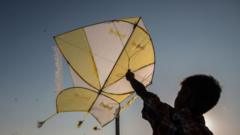In Indonesia, especially within two kilometers of Jakarta's bustling Soekarno-Hatta International Airport, children are engaged in a spirited pastime of kite-flying amidst the roar of planes overhead. Young flyers are often caught between the joy of their cherished hobby and the stern warnings issued by airport authorities about the dangerous proximity of kites to air traffic.
At the heart of this dilemma are child kite flyers, like seven-year-old Atif, who recalls a time when the sight of patrolling airport officials would send him running. “Now I’m braver,” he states. However, the risks are genuine. Just recently, flights were disrupted when kites interfered with operations at the airport, leading to diversions and significant safety concerns.
Putu Eka Cahyadi, the head of the airport authority, emphasizes the potential hazards posed by kite-flying, stating that they are a “serious risk to flight safety.” A 2024 incident in Bali saw a helicopter crash when entangled in kite string, further enforcing their concerns over flying objects near flight paths.
While many authorities have convened to work out solutions, solutions are scarce in the face of entrenched tradition. "Kite flying is deeply woven into our culture, transcending generations," highlights Asep Irawan from the Indonesia Kite Museum. The tradition includes various purposes from agricultural to spiritual, anchoring it deeply in Indonesia's fabric.
Though governmental task forces have been created to address this conundrum, with campaigns urging children to engage in alternative sports, kite-flying persists as a predominant activity. Children express difficulty finding safer venues for their beloved pastime as Jakarta struggles with shrinking green spaces, losing 31% of its urban greenery over the past two decades to development and urbanization.
As the conflict continues, these young enthusiasts find solace in their local paddies, where they not only fly kites but also compete with one another, displaying their handmade creations. Rasha, a 17-year-old kite maker, shares insights of juggling between the thrill of flying and the risks involved, detailing encounters with officials that have led to confiscation of his kites, and the legal threats surrounding kite-flying near airports.
Despite the obstacles, children like Rasha hold onto their passion, indicating a tenacity to maintain both their cultural heritage and the joy that kite-flying brings, even as they navigate the complicated dynamics of safety and tradition. This juxtaposition highlights an ongoing struggle: how to honor and preserve Indonesia's cherished kite-flying culture while promoting safety and awareness in an increasingly urbanized environment.
At the heart of this dilemma are child kite flyers, like seven-year-old Atif, who recalls a time when the sight of patrolling airport officials would send him running. “Now I’m braver,” he states. However, the risks are genuine. Just recently, flights were disrupted when kites interfered with operations at the airport, leading to diversions and significant safety concerns.
Putu Eka Cahyadi, the head of the airport authority, emphasizes the potential hazards posed by kite-flying, stating that they are a “serious risk to flight safety.” A 2024 incident in Bali saw a helicopter crash when entangled in kite string, further enforcing their concerns over flying objects near flight paths.
While many authorities have convened to work out solutions, solutions are scarce in the face of entrenched tradition. "Kite flying is deeply woven into our culture, transcending generations," highlights Asep Irawan from the Indonesia Kite Museum. The tradition includes various purposes from agricultural to spiritual, anchoring it deeply in Indonesia's fabric.
Though governmental task forces have been created to address this conundrum, with campaigns urging children to engage in alternative sports, kite-flying persists as a predominant activity. Children express difficulty finding safer venues for their beloved pastime as Jakarta struggles with shrinking green spaces, losing 31% of its urban greenery over the past two decades to development and urbanization.
As the conflict continues, these young enthusiasts find solace in their local paddies, where they not only fly kites but also compete with one another, displaying their handmade creations. Rasha, a 17-year-old kite maker, shares insights of juggling between the thrill of flying and the risks involved, detailing encounters with officials that have led to confiscation of his kites, and the legal threats surrounding kite-flying near airports.
Despite the obstacles, children like Rasha hold onto their passion, indicating a tenacity to maintain both their cultural heritage and the joy that kite-flying brings, even as they navigate the complicated dynamics of safety and tradition. This juxtaposition highlights an ongoing struggle: how to honor and preserve Indonesia's cherished kite-flying culture while promoting safety and awareness in an increasingly urbanized environment.


















